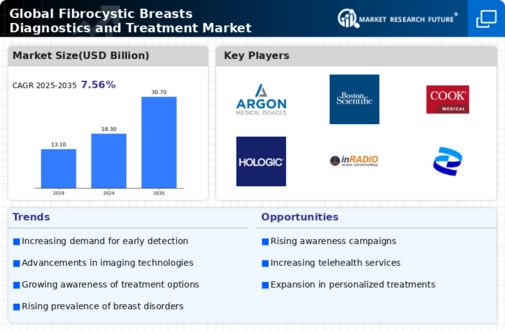The Fibrocystic Breasts Diagnostics Treatment Market is characterized by a competitive landscape that is increasingly shaped by innovation, strategic partnerships, and technological advancements. Key players such as GE Healthcare (US), Siemens Healthineers (DE), and Hologic (US) are at the forefront, leveraging their extensive research and development capabilities to enhance diagnostic accuracy and treatment efficacy. These companies appear to be focusing on integrating advanced imaging technologies and artificial intelligence (AI) into their offerings, which may significantly improve patient outcomes and streamline clinical workflows. The collective strategies of these firms suggest a trend towards a more interconnected and technologically sophisticated market environment.
In terms of business tactics, companies are increasingly localizing manufacturing to reduce costs and enhance supply chain efficiency. This approach seems to be particularly relevant in the context of the Fibrocystic Breasts Diagnostics Treatment Market, which is moderately fragmented, with several players vying for market share. The influence of major companies is substantial, as they not only set industry standards but also drive innovation through competitive pressure, thereby shaping the overall market structure.
In November 2025, Siemens Healthineers (DE) announced a strategic partnership with a leading telehealth provider to enhance remote diagnostic capabilities for fibrocystic breast conditions. This collaboration is likely to expand access to care, particularly in underserved regions, and may facilitate earlier detection and intervention, which is crucial for patient management. The strategic importance of this move lies in its potential to integrate telehealth solutions with traditional diagnostic methods, thereby creating a more holistic approach to patient care.
In October 2025, Hologic (US) launched a new AI-driven imaging system designed specifically for breast diagnostics, which is expected to improve the accuracy of fibrocystic breast assessments. This innovation not only underscores Hologic's commitment to advancing diagnostic technology but also positions the company as a leader in the integration of AI within the healthcare sector. The implications of this development are profound, as it may lead to more precise diagnoses and tailored treatment plans, ultimately enhancing patient outcomes.
In September 2025, GE Healthcare (US) expanded its product portfolio by acquiring a startup specializing in advanced imaging analytics. This acquisition appears to be a strategic move to bolster GE's capabilities in data-driven diagnostics, particularly in the realm of fibrocystic breast conditions. The integration of advanced analytics into their existing systems could provide healthcare professionals with deeper insights, thereby improving decision-making processes and patient management strategies.
As of December 2025, the competitive trends in the Fibrocystic Breasts Diagnostics Treatment Market are increasingly defined by digitalization, sustainability, and the integration of AI technologies. Strategic alliances among key players are shaping the landscape, fostering innovation and enhancing service delivery. Looking ahead, it is anticipated that competitive differentiation will evolve from traditional price-based strategies to a focus on technological innovation, reliability in supply chains, and the ability to deliver superior patient care. This shift may redefine the competitive dynamics, emphasizing the importance of adaptability and forward-thinking in a rapidly changing market.

















Leave a Comment